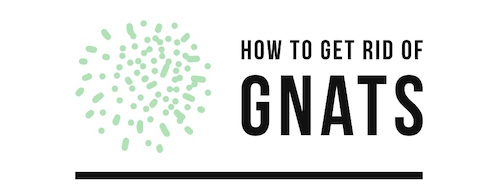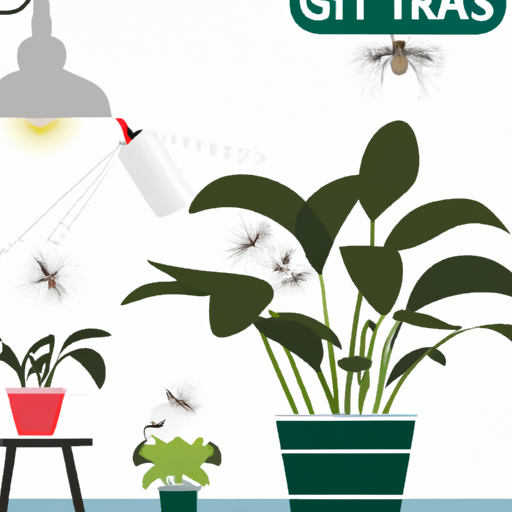How to Identify Gnats in Houseplants and What to Do About Them
Gnats are small, flying insects that can be found in houseplants. They are usually black or dark brown and measure between 1/8 and 1/10 of an inch long. Gnats feed on decaying organic matter, such as plant roots, fungi, and other plant debris. They can also feed on the sap of plants.
Identifying gnats in houseplants is relatively easy; they will often be seen hovering around the soil surface or flying around the leaves of a plant. If you suspect that your houseplant has gnats, you should inspect it closely for signs of infestation. Look for small white larvae near the soil surface or on the underside of leaves; these larvae are usually about 1/8 inch long and have a shiny appearance. You may also see adult gnats flying around your plants; they will look like tiny flies with long legs and antennae.
Once you have identified that your houseplant has gnats, there are several steps you can take to get rid of them:
1) Remove any dead or decaying material from around the base of your plant to reduce food sources for the gnats;
2) Increase air circulation by moving your plants away from windowsills or other areas where air is stagnant;
3) Use sticky traps to capture adult gnats before they lay eggs in your soil;
4) Treat affected areas with an insecticidal soap solution to kill any remaining larvae or adults;
5) Repot affected plants into fresh potting mix to remove any remaining eggs or larvae from old soil mix;
6) Finally, if all else fails, consider using a natural insecticide such as neem oil to control populations of adult gnats in severe cases.
By following these steps carefully and regularly inspecting your houseplants for signs of infestation, you should be able to keep populations under control without resorting to chemical treatments which could harm beneficial insects living in your home environment!
Natural Ways to Get Rid of Gnats in Houseplants
Gnats are a common problem in houseplants, but there are several natural ways to get rid of them. Here are some tips for getting rid of gnats in your houseplants:
1. Remove any dead or decaying leaves and stems from the plant. This will help reduce the number of gnats that may be living on the plant.
2. Place yellow sticky traps near the plants to catch adult gnats as they fly around looking for food and water sources.
3. Make a homemade insecticidal soap by mixing one tablespoon of dish soap with one quart of warm water and spraying it directly onto the affected plants every few days until you no longer see any signs of gnat activity.
4. Use neem oil, an organic pesticide derived from neem trees, to kill off adult gnats and their larvae on contact without harming beneficial insects like bees or ladybugs that may also be present in your home garden or greenhouse environment.
5. Introduce predatory insects such as green lacewings or parasitic nematodes into your home garden or greenhouse environment to help control populations of pests like fungus gnats naturally over time without using harsh chemicals that could harm other beneficial organisms living in your space as well as yourself and family members if inhaled or ingested accidentally during application processes..
The Best Insecticides for Controlling Gnats in Houseplants
Gnats are a common problem in houseplants, and can be difficult to control. Fortunately, there are several insecticides available that can help keep these pests at bay. Here is a list of the best insecticides for controlling gnats in houseplants:
1. Neem Oil: Neem oil is an organic insecticide derived from the neem tree. It works by disrupting the reproductive cycle of insects, preventing them from laying eggs and reproducing. It also has antifungal properties which can help prevent fungal diseases in plants.
2. Pyrethrin-Based Insecticides: Pyrethrin-based insecticides are derived from chrysanthemum flowers and work by paralyzing or killing insects on contact. They are effective against many types of pests, including gnats, but should be used with caution as they can also harm beneficial insects such as bees and butterflies if not applied properly.
3. Spinosad Products: Spinosad products contain naturally occurring bacteria that attack the nervous system of insects when ingested or contacted directly on their bodies or legs. These products have low toxicity to humans and pets but should still be used with caution around food crops or edible plants as they may cause irritation if ingested in large amounts over time.
4 .Insecticidal Soaps: Insecticidal soaps work by breaking down the protective outer layer of an insect’s body, causing it to dehydrate and die quickly without leaving any residue behind on your plants or furniture surfaces nearby . They are safe for use around children and pets but should not be used on edible crops due to their potential for causing skin irritation if ingested in large amounts over time .
5 .Bacillus Thuringiensis (BT): BT is a naturally occurring bacteria that attacks only certain types of caterpillars when ingested , making it safe for use around beneficial insects such as bees while still being effective against gnats . It does not leave any residue behind after application , making it ideal for indoor use where other pesticides may pose a risk to humans or pets .
Tips for Preventing Gnats from Infesting Your Houseplants
1. Keep your houseplants clean and free of debris. Remove any dead leaves or stems, as these can attract gnats.
2. Make sure the soil is not overly wet or damp, as this can create an ideal environment for gnats to breed in. Allow the top layer of soil to dry out between waterings and avoid overwatering your plants.
3. Use a commercial insecticide specifically designed for controlling gnats on houseplants, following all instructions carefully when applying it to your plants.
4. Place yellow sticky traps near infested plants to catch adult gnats and reduce their population in the area around your houseplants.
5. Introduce beneficial insects such as predatory mites into the soil of infested plants; these will feed on larvae and help keep populations under control naturally without using chemicals or pesticides that may be harmful to other beneficial insects in your home environment such as bees or ladybugs .
6 . Repot any infested plants with fresh potting mix that does not contain any organic matter which could provide food sources for larvae; this will help reduce their numbers significantly over time .
How to Use Beneficial Insects to Control Gnat Populations in Your Home
Gnats are small, annoying insects that can be found in many homes. While they may not cause any serious damage, they can be a nuisance and difficult to get rid of. Fortunately, there are several ways to control gnat populations in your home using beneficial insects.
One way to control gnat populations is by introducing predatory mites into the environment. Predatory mites feed on other small insects such as gnats and can help reduce their numbers significantly over time. These mites should be released in areas where you have seen the most activity from the gnats, such as near windows or doors where they may enter your home.
Another option is to introduce parasitic wasps into your home environment. These wasps lay their eggs inside of other insect larvae, including those of gnats, which then hatch and feed on the host insect until it dies. This helps reduce the number of adult gnats that will emerge from pupae later on and keeps their population under control over time.
Finally, you can also use nematodes to help reduce gnat populations in your home environment. Nematodes are microscopic worms that feed on other small insects like larvae and pupae of various species including those of gnats. They should be applied directly onto soil or other surfaces where you have seen evidence of activity from these pests for best results over time.
By introducing beneficial insects into your home environment such as predatory mites, parasitic wasps or nematodes you can effectively control the population size of pesky little pests like gnats without having to resort to chemical treatments or sprays which could potentially harm people or pets living in your household too!

